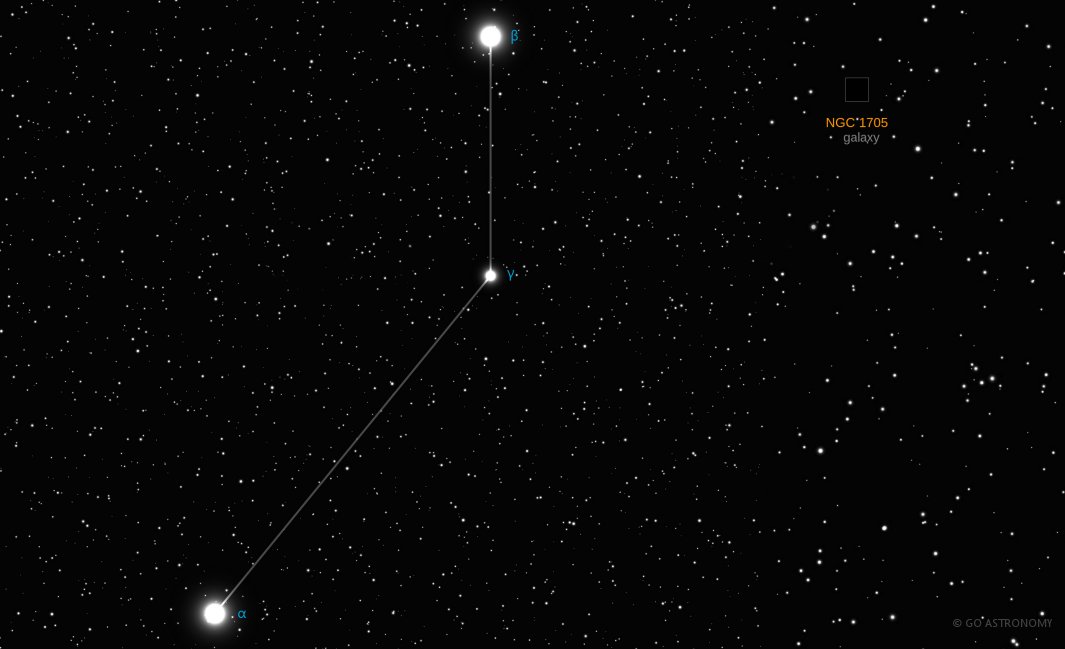Pictor, the Painter's Easel (Pic)
(PICK-ter)
The Southern constellation of Pictor, the Painter's Easel, is best viewed in Winter during the month of February.
Pictor is the 59th largest constellation. It's brightest star is Alpha Pictoris at magnitude 3.30. The boundary of the Pictor constellation contains 6 stars that host known exoplanets.
- Pronunciation:
- PICK-ter
- Meaning:
- Painter's Easel
- Genitive:
- Pictoris
- Abbreviation:
- Pic
- Constellation Family:
- LaCaille
- Hemisphere:
- Southern
- Quadrant:
- SQ1
- Visibility:
- 26° N - 90° S
- Best viewing month*:
- February
- Area:
- 247 sq. degrees
- Size:
- 59th largest
- Right Ascension (avg):
- 5h 23m
- Declination (avg):
- -54°
- Brightest star:
- Alpha Pictoris (3.30)
- Stars with planets:
- 6
- Messier objects:
- |
- Caldwell objects:
- |
Brightest Stars in Pictor
The 10 brightest stars in the constellation Pictor by magnitude.
- Star
- Magnitude
- Spectral class
- Alpha Pictoris (α Pic)
- 3.3
- A7IV
- Beta Pictoris (β Pic)
- 3.85
- A5V
- Gamma Pictoris (γ Pic)
- 4.5
- K1III
- Delta Pictoris (δ Pic)
- 4.72
- B0.5IV
- HD 42540
- 5.04
- K2/K3III
- Eta Pictoris (η2 Pic)
- 5.05
- M2IIIvar
- HD 39640
- 5.16
- G8III
- HD 46355
- 5.2
- K0III
- HD 40292
- 5.29
- F0Ve
- Lambda Pictoris (λ Pic)
- 5.3
- K0/K1III
Galaxies in Pictor
The most notable galaxies in the constellation Pictor. Also see all galaxies.
The Painter's Easel in the Night Sky
The constellation Pictor, representing a painter's easel, is an interesting feature of the southern sky. Despite its relative obscurity, it hosts a variety of celestial objects, including some notable stars and intriguing deep-sky phenomena, which offer an enriching observational experience for astronomers and stargazers alike.
Historical Overview
Pictor is a relatively modern constellation, first introduced in the 18th century by French astronomer Nicolas Louis de Lacaille. After observing and cataloguing nearly 10,000 southern stars during his stay at the Cape of Good Hope, Lacaille established 14 new constellations, with Pictor being one of them. The constellation is now one of the 88 modern constellations recognized by the International Astronomical Union (IAU).
Location and Main Features
Located in the second quadrant of the Southern Hemisphere (SQ2), Pictor is observable at latitudes between +26? and -90?. It is nestled amongst several other constellations, including Carina and Columba to the north, Caelum to the west, Volans to the south, and Dorado and Puppis to the east. Covering an area of 247 square degrees, Pictor is the 59th largest constellation in the night sky.
Main Stars in Pictor
The constellation Pictor is not home to any particularly bright stars. Its brightest star, Alpha Pictoris, is a white main sequence star of spectral type A7V with an apparent magnitude of 3.3. Another notable star is Beta Pictoris, a relatively young star surrounded by a large disk of dust and debris. Beta Pictoris has garnered a lot of interest due to its circumstellar disk, which is believed to be a protoplanetary disk, a region where planets are forming.
Deep Sky Objects
Despite its faint stars, Pictor hosts several interesting deep sky objects. One of the most fascinating is the Pictor A galaxy. This is a large galaxy with an active galactic nucleus that is spewing out jets of particles, one of which is creating a giant X-ray bubble over a million light-years long. Observing these objects requires a powerful telescope, but their scientific value and the insights they offer into the universe make the effort worthwhile.
Observation
Pictor is best seen in the Southern Hemisphere during the month of February. For observers in the Northern Hemisphere, viewing Pictor might be a challenge due to its southerly location. However, observers located in southern parts of the Northern Hemisphere may have a glimpse of Pictor low on their southern horizon during winter months.
* Constellation shown for northen hemisphere skies. For the southern hemisphere, constellations appear rotated 180 degrees (upside-down and left-right reversed) from what is shown. Remember that seasons are reversed too - summer in northern latitudes is winter in southern latitudes.
** Circumpolar constellations are visible year-round in the hemisphere listed (and not at all in the opposite hemisphere).





